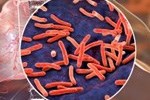Comparative Physiology and Clinical Sciences (CPCS) - Research Programme Projects
-
A solution right under our nose? Exploring health implications and public demand for brachycephalic ‘designer’ outcrosses
Brachycephalic (flat-faced) dogs continue to grow in popularity internationally despite their well-documented health challenges. This study explores two questions: (1) Do brachycephalic-outcrosses exhibit improved respiratory and ‘innate’ health characteristics compared to their extreme-brachycephalic parent-breed?; (2) Do brachycephalic-outcrosses meet the aesthetic preferences of people who desire extreme-brachycephalic purebreds?
-
Investigation of clinical predictors of equine umbilical cord torsion and abortion
Researchers at the RVC are leading a collaboration with colleagues at Cornell University, Rossdales Laboratories and Hagyard Equine Medical Institute to unravel the reason the umbilical cord twists excessively in mid-pregnancy and new ways to be able to detect the twisting prior to the pregnancy being aborted. Epidemiological modelling is being utilised to carry out evidence-based refinement of the current diagnostic criteria for UCT, allowing for more reliable comparison of distinct populations within the UK and overseas.
-
Retraining and rehoming former UK racehorses
The racing industry is committed to the health and welfare of all horses bred for racing, throughout their lifetime. However, there is a need to better understand what happens to racehorses when they leave racing or training, and what makes them suitable for a successful career in other equestrian sports disciplines, as leisure horses or companions. The overarching aims of this project are to provide a comprehensive overview of the landscape of former racehorse rehoming and to better understand what factors influence a former racehorse’s suitability for a second career and/or successful rehome.
-
SanSkills: Empowering San women in Botswana through equipment and training for wildlife conservation
This project combines women’s empowerment with wildlife conservation to benefit the whole San community and contribute to the survival of Botswana’s iconic endangered species.
As well as providing a training and employment opportunity for the San women, it is hoped the project will contribute to reducing human/wildlife conflict and poaching in the area.
-
Equine Safety and Welfare in British Horseracing
The racing industry is committed to improving the welfare and safety of racehorses.
Better understanding of risk factors for injury and fatality can inform evidence-based strategies to reduce their occurrence.
-
Understanding the genetic basis of catastrophic bone fracture in Thoroughbred horses using stem cells.
Bone fractures are a significant welfare problem in the Thoroughbred racing industry. Previous work has demonstrated that fracture is a complex condition with both environmental and genetic factors risk factors. However, the specific genetic factors that underpin fracture risk have not been identified. This has proved problematic to work out using patients due to the difficulty in accessing bone tissue and the large variability in exposure to environmental risk factors.
-
Using pluripotent stem cells to improve tendon regeneration in horses
Tendon injuries are common in horses taking part in a wide range of disciplines. After an injury, adult tendons undergo poor natural regeneration, instead repairing with functionally inferior scar tissue which leads to high re-injury rates.
Improving tendon regeneration is therefore key to reducing re-injury rates and enabling more horses to return to work following an injury.
-
AIRSCAN
The AIRSCAN project uses a modified research aircraft for aerial survey and data acquisition. During its first deployment in the LOCATE project, the aircraft allowed us to understand more about behaviour and locomotion in wild, free-ranging animals in southern Africa. The on-board technology helped reveal new insights into how animals interact with their natural environment, which will aid conservation and land management. The modified aircraft was originally built for studying large African carnivores and their prey in the savannah of northern Botswana. The researchers developed new ways of recording the detailed movements of these animals without disturbing them, using our wildlife tracking collars.
-
Researching heart disease in dogs - HAMLET and EPIC
Whilst there are a number of disease processes that affect the canine heart, mitral valve disease (MVD) is by far the most common. The HAMLET study aims to catch signs of this disease early by evaluating whether levels of serum cardiac biomarkers, interpreted alongside a patient’s clinical information, can determine which dogs are likely to have cardiac enlargement and therefore would benefit from further investigation or treatment. The EPIC study sought to determine whether the administration of pimobendan to dogs with preclinical MVD would delay the onset of clinical signs.
-
Epilepsy in companion animals
Researchers and clinicians at the RVC have devoted more than a decade of work to improving our understanding of epilepsy in dogs, as well as cats. Ongoing RVC epilepsy research is improving the characterisation of this chronic disorder and its comorbidities, develops technology to aid its long-term management for vets and owners, and identifies fresh new ways to manage this age-old disorder.
-
Machine learning algorithms for predicting drug resistance against tuberculosis in people
Tuberculosis disease (TB), caused by Mycobacterium tuberculosis, is an important global public health issue, and its drug resistance, caused by genetic mutations in the M. tuberculosis genome, poses serious challenges for effective control. Current molecular diagnostic tests are imperfect as they do not target all resistance mechanisms and drugs, nor do they inform on transmission clusters, and are therefore unable to guide completely effective individualised therapy.
-
Canine diabetes
Certain breeds of dog, including the Samoyed, Cairn and Tibetan terriers are predisposed to developing diabetes, whereas others, including the boxer and German shepherd dog, are less susceptible. Such breed differences suggest that there is a genetic component to disease susceptibility.
-
Bioelectronics
Bioelectronic medicine, or electroceuticals, is a rapidly developing therapeutic field in which biomedical devices are used electrically to block, record, or stimulate neural activity as an alternative to drugs.
Pharmaceutical and surgical intervention are not always as effective as we would like or desirable, especially in species that are extremely sensitive to drugs, such as horses. Bioelectronic medicine allows us to intervene to help patients without the risks associated with other interventions.
-
Ethics of animal use and management
Animal welfare issues often arise when there are conflicts of interest between humans and animals. This poses challenges around whose interests to prioritise, and what actions can be taken to produce the best moral outcome. The needs and wants of human, animal, and even environmental stakeholders must be understood and evaluated to decide what is the right course of action, but different ethicists and stakeholders may disagree about the conclusions of any ethical analysis. For example, unnecessary suffering must not be caused to legally protected animals, but what counts as ‘suffering’, when is it really ‘necessary’, and which animals should be protected? Evidence must be gathered and some consensus must be agreed upon as to weight the different possible actions.
-
Development of welfare assessment protocols and technology
Assessment of animal welfare is continually being improved using new insights in animal behaviour, non-invasive physiological methods, animal-environment interactions, and novel monitoring systems for animal responses and behaviours.
Some of our work aims to develop a more fundamental understanding of which measures (e.g. behaviour, activity, posture etc) should most appropriately be targeted with sensor technology. However, technology is not always feasible (or even desirable) in some sectors, so we develop welfare assessments that are valid and practical in whatever context they are needed and tailored to the specific welfare aim.
-
Fundamental understanding of welfare
Animal welfare refers to animal feelings, health, and environmental suitability. These projects explore which animals are sentient and what feelings they have, and how behaviour, health, environments, and welfare interrelate. We use a wide range of techniques to investigate these fundamental questions, each of which is tailored to the particular hypothesis and species involved. Emotions are subjective (private) to the individual experiencing them, which makes them challenging to investigate scientifically.
















